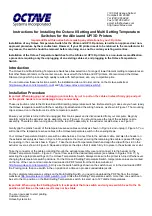
LPD behaviour
LPD behaviour
Reception and queueing of the received print job
Jobs sent by the users are received by the printer and spooled. Multiple jobs can be received in
parallel. At this state, jobs are visible via lpq and removable via lprm.
Job visibility
The spooled jobs are submitted to the PDL data processing module one at a time, in FIFO order.
The PDL data processing module generates bitmaps for each submitted job.
When a job is fully ripped by the PDL unit it is removed from the Spool queue, and then will not
be visible through lpq or removable through lprm. On the imagePRESS C7010VPS series, the job
is visible on the local user interface as soon as spooling starts.
Mapping of lpd jobs to requests
An LPD job can consist of multiple files. Each file in an LPD job will result in a separate request on
the IBB. This makes each file visible in the mailbox as a separate document.
This allows a user to manipulate each document individually on the system console (print,
delete, ...).
File size status
The file size information provided by lpq command represents the amount of data spooled on the
printer for a given job.
Two situations can occur:
• A PDL file is sent.
The size returned by lpq is equal to the size of the sent file.
• A job that contains a job ticket data and PDL data is sent.
The size returned by lpq is the size of only the PDL file. This is because the job ticket is not
spooled on disk.
Ports
This section describes which network traffic must be allowed for supporting the LPD protocol.
LPD ports
Protocol
Source port
Destination port
Direction
TCP
Any
515
Incoming
TCP
515
Any
Outgoing
Job reception disabled
When the LPD job reception is disabled, the LPD will no longer accept new jobs, but it will
respond to lpq and lprm requests. The controller status as reported by ‘lpq’ will indicate that
reception is disabled.
LPD behaviour
Chapter 3 - The LPD connection
43
imagePRESS C7010VPS series v2.2
Summary of Contents for imagePRESS C7010VPS series
Page 8: ...Contents 8 imagePRESS C7010VPS series v2 2...
Page 9: ...Chapter 1 Introduction...
Page 14: ...Supported media 14 Chapter 1 Introduction imagePRESS C7010VPS series v2 2...
Page 15: ...Chapter 2 PRISMAsync...
Page 29: ...Chapter 3 The LPD connection...
Page 45: ...Chapter 4 The socket connection...
Page 51: ...Chapter 5 Adobe PostScript 3...
Page 64: ...Bind 64 Chapter 5 Adobe PostScript 3 imagePRESS C7010VPS series v2 2...
Page 86: ...Staple 86 Chapter 5 Adobe PostScript 3 imagePRESS C7010VPS series v2 2...
Page 89: ...Trim Chapter 5 Adobe PostScript 3 89 imagePRESS C7010VPS series v2 2...
Page 99: ...Chapter 6 PDF...
Page 117: ...Chapter 7 Colour management...
Page 133: ...Chapter 8 Accounting...
Page 150: ...Implementation aspects 150 Chapter 8 Accounting imagePRESS C7010VPS series v2 2...
Page 151: ...Chapter 9 SNMP...
Page 159: ...Example in pseudo code Chapter 9 SNMP 159 imagePRESS C7010VPS series v2 2...
Page 222: ...ppmPortGroup 222 Chapter 9 SNMP imagePRESS C7010VPS series v2 2...
Page 223: ...Chapter 10 JDF interface specification...
Page 291: ...Basic JDF ticket Chapter 10 JDF interface specification 291 imagePRESS C7010VPS series v2 2...
Page 297: ...Chapter 11 SMB printing...
Page 303: ...Chapter 12 Hot folder printing...
Page 306: ...Hot folder 306 Chapter 12 Hot folder printing imagePRESS C7010VPS series v2 2...
Page 307: ...Chapter 13 Scan to file and scan to email...
Page 313: ...Chapter 14 SRA IPDS...
Page 361: ......
















































